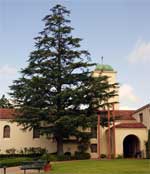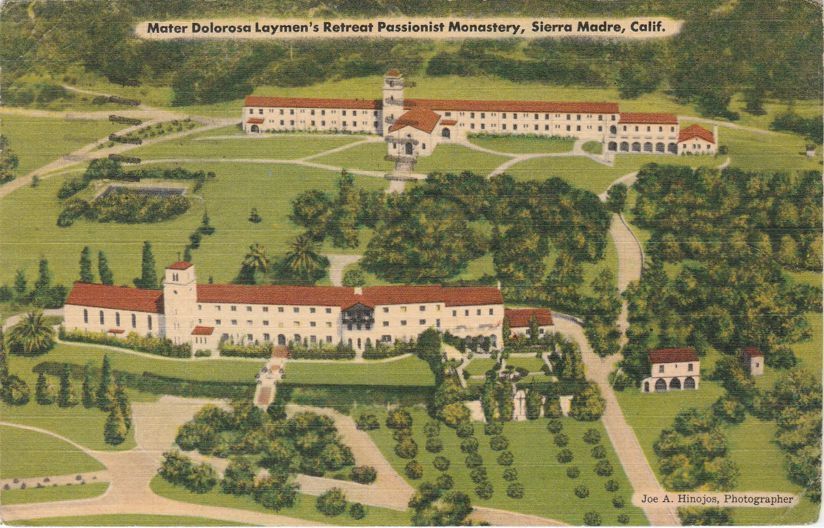Places: Mater Dolorosa Retreat, Sierra Madre, California
 Mater Dolorosa Retreat sits nestled against the San Gabriel Mountains, looking out over the LA basin, bearing witness to the peace and solitude of an area better known for traffic jams and Valley Girls. For those of us, born and raised in the Midwest, in the Passionist formation program of the 1960s, Sierra Madre seemed like a Shangri-La far removed from our changing seasons, flatlands, and vistas of wheat, corn, and cattle. As students, it was the last place any of us expected to see during our studies so it remained a place of dreams.
Mater Dolorosa Retreat sits nestled against the San Gabriel Mountains, looking out over the LA basin, bearing witness to the peace and solitude of an area better known for traffic jams and Valley Girls. For those of us, born and raised in the Midwest, in the Passionist formation program of the 1960s, Sierra Madre seemed like a Shangri-La far removed from our changing seasons, flatlands, and vistas of wheat, corn, and cattle. As students, it was the last place any of us expected to see during our studies so it remained a place of dreams.
In May of 2011, I drove from Phoenix to Sierra Madre, through desert and scrub, Palm Springs, and the Imperial Valley. Six hours later, after crawling through the traffic of LA, I arrived at the gates of Mater Dolorosa, revived by the fact that people and traffic had disappeared and I was about to see a place I had only heard about for 45 years.
Fr. Rob Carbonneau, C.P. interviewed Fr. Neil Parsons, C.P. in 1998 about the Passionist foundations of Holy Cross Province. Here's what he had to say about Mater Dolorosa:
"Land in Sierra Madre, in Pasadena, California had been bought in the early 1920s by Passionist Provincial Eugene Creegan (1920-1923, 1923-1926, 1929-1932, 1932-1935) who loved the Los Angeles region. Provincial Jerome Reutermann (1908-1911, 1911-1914, 1926-1929) felt the opposite about the west coast. While a residence existed in Pasadena, building of the monastery did not occur until the 1930's when the Detroit monastery was completed. Fr. Edmund Walsh, CP and Bill Shiltz, a layman contractor and architect, supervised the project which was built quite cheaply during the Depression. Every day men would line up "pleading for a day's work." Sierra Madre was on the "outskirts" of province life in 1937. Some, however, felt like "orphans " and out of touch with the rest of the province. Others loved southern California for the weather and the distance from leadership. Three day travel time between the west coast and the Midwest did endear Passionists to the location. In the 1940's the Passionist Sacred Eloquence program was located there."
(1998. Robert E. Carbonneau, C.P., Ph.D., Passionist Life in Holy Cross Province during the Depression Era)
 The monastery used to sit just down the hill from the retreat center but earthquakes and mudslides in June of 1991 led to its eventual demolition. On its site is now a beautiful garden memorializing the original monastic site and dedicated to the Seven Sorrows of Mary. As one looks up the hill, the retreat house is just visible through the cypress and eucalyptus trees, the flowering bushes, and wildflowers. In the cool shadows of this forest one can see the small cemetery and the meditative walk of the Stations of the Cross. On Good Friday of 2011, 3,500 people traversed this garden in silent thought and prayer. It now lay quiet, bees buzzing, butterflies flitting, immersed in a silence almost one hundred years old.
The monastery used to sit just down the hill from the retreat center but earthquakes and mudslides in June of 1991 led to its eventual demolition. On its site is now a beautiful garden memorializing the original monastic site and dedicated to the Seven Sorrows of Mary. As one looks up the hill, the retreat house is just visible through the cypress and eucalyptus trees, the flowering bushes, and wildflowers. In the cool shadows of this forest one can see the small cemetery and the meditative walk of the Stations of the Cross. On Good Friday of 2011, 3,500 people traversed this garden in silent thought and prayer. It now lay quiet, bees buzzing, butterflies flitting, immersed in a silence almost one hundred years old.
The bustle lies further up the hill. The chapel and retreat house were alive with people. Five Passionists inhabit the monastic environs of the third floor to the east of the retreat house proper. Fr. Alan Phillip (†1939-2021) was the superior, Fr. Pat Brennan (now in Detroit), the retreat director, along with Frs. Michael Hoolahan (†1932-2018), Alfred Pooler (†1933-2015), and Bro. John Rockenbach. They are well outnumbered by the lay staff who see to the efficient operation of the facility, a retreat house vitally alive both during the week and weekend.
I roamed the gardens every morning, taking pictures (some of which you see below), thinking back to a time when I was part of this wider community of men. In the evenings, Alan, Patrick, Alfred, Mike, and I would sit and tell the stories common to us all. Mike and Alfred taught at Mother of Good Counsel during our years there, History and Latin, respectively. We shared pictures that dated back to the 1940s and this brought more stories, laughter, and an occasional moment of reflection. Ears must have been ringing everywhere!
While Mater Dolorosa is indeed a Shangri-La, it is also defined by the spirit of the men and women who have made it their life's work, behind an altar, over a shrub, in a kitchen, or behind a desk. Its past informs its future, a future bright with peace and light.
I have tried to capture the peace and beauty of Mater Dolorosa in the pictures below. if you click on the picture, a larger image will appear. Use your browser's Back button or arrow to return to this page.
|
|
||
 |
|
|
|
|
|
|